Improving the Accuracy of Tree Species Mapping by Sentinel-2 Images Using Auxiliary Data—A Case Study of Slyudyanskoye Forestry Area near Lake Baikal
Abstract
1. Introduction
2. Materials and Methods
2.1. Data for Training
2.1.1. Vegetation Indices
2.1.2. Soil Data
2.1.3. Climate Data
2.1.4. Topographic Data
2.1.5. Forest Canopy Height
2.2. Model Evaluation
2.3. Features Combinations
2.4. Training Dataset
2.5. Data Preprocessing
3. Results
4. Discussion
4.1. Effect of Auxiliary Data on Model Performance
4.2. Limitations of the Method and Future Development
5. Conclusions
Supplementary Materials
Funding
Data Availability Statement
Conflicts of Interest
References
- Pu, R. Mapping Tree Species Using Advanced Remote Sensing Technologies: A State-of-the-Art Review and Perspective. J. Remote Sens. 2021, 2021, 9812624. [Google Scholar] [CrossRef]
- Bonan, G.B. Forests, Climate, and Public Policy: A 500-Year Interdisciplinary Odyssey. Annu. Rev. Ecol. Evol. Syst. 2016, 47, 97–121. [Google Scholar] [CrossRef]
- Chiarucci, A.; Piovesan, G. Need for a Global Map of Forest Naturalness for a Sustainable Future. Conserv. Biol. 2020, 34, 368–372. [Google Scholar] [CrossRef] [PubMed]
- Bychkov, I.; Popova, A. Forest Landscape Model Initialization with Remotely Sensed-Based Open-Source Databases in the Absence of Inventory Data. Forests 2023, 14, 1995. [Google Scholar] [CrossRef]
- Talukdar, S.; Singha, P.; Mahato, S.; Shahfahad; Pal, S.; Liou, Y.-A.; Rahman, A. Land-Use Land-Cover Classification by Machine Learning Classifiers for Satellite Observations—A Review. Remote Sens. 2020, 12, 1135. [Google Scholar] [CrossRef]
- Nguyen, T.H.; Jones, S.; Soto-Berelov, M.; Haywood, A.; Hislop, S. Landsat Time-Series for Estimating Forest Aboveground Biomass and Its Dynamics across Space and Time: A Review. Remote Sens. 2019, 12, 98. [Google Scholar] [CrossRef]
- Grabska, E.; Hostert, P.; Pflugmacher, D.; Ostapowicz, K. Forest Stand Species Mapping Using the Sentinel-2 Time Series. Remote Sens. 2019, 11, 1197. [Google Scholar] [CrossRef]
- Ma, M.; Liu, J.; Liu, M.; Zeng, J.; Li, Y. Tree Species Classification Based on Sentinel-2 Imagery and Random Forest Classifier in the Eastern Regions of the Qilian Mountains. Forests 2021, 12, 1736. [Google Scholar] [CrossRef]
- Hartling, S.; Sagan, V.; Sidike, P.; Maimaitijiang, M.; Carron, J. Urban Tree Species Classification Using a WorldView-2/3 and LiDAR Data Fusion Approach and Deep Learning. Sensors 2019, 19, 1284. [Google Scholar] [CrossRef]
- Wang, J.; Bretz, M.; Dewan, M.A.A.; Delavar, M.A. Machine Learning in Modelling Land-Use and Land Cover-Change (LULCC): Current Status, Challenges and Prospects. Sci. Total Environ. 2022, 822, 153559. [Google Scholar] [CrossRef]
- Wessel, M.; Brandmeier, M.; Tiede, D. Evaluation of Different Machine Learning Algorithms for Scalable Classification of Tree Types and Tree Species Based on Sentinel-2 Data. Remote Sens. 2018, 10, 1419. [Google Scholar] [CrossRef]
- Axelsson, A.; Lindberg, E.; Reese, H.; Olsson, H. Tree Species Classification Using Sentinel-2 Imagery and Bayesian Inference. Int. J. Appl. Earth Obs. Geoinf. 2021, 100, 102318. [Google Scholar] [CrossRef]
- Bychkov, I.V.; Ruzhnikov, G.M.; Fedorov, R.K.; Popova, A.K.; Avramenko, Y.V. On Classification of Sentinel-2 Satellite Images by a Neural Network ResNet-50. Comput. Opt. 2023, 47, 474–481. [Google Scholar] [CrossRef]
- Lim, J.; Kim, K.-M.; Kim, E.-H.; Jin, R. Machine Learning for Tree Species Classification Using Sentinel-2 Spectral Information, Crown Texture, and Environmental Variables. Remote Sens. 2020, 12, 2049. [Google Scholar] [CrossRef]
- Liu, Y.; Gong, W.; Xing, Y.; Hu, X.; Gong, J. Estimation of the Forest Stand Mean Height and Aboveground Biomass in Northeast China Using SAR Sentinel-1B, Multispectral Sentinel-2A, and DEM Imagery. ISPRS J. Photogramm. Remote Sens. 2019, 151, 277–289. [Google Scholar] [CrossRef]
- Lechner, M.; Dostálová, A.; Hollaus, M.; Atzberger, C.; Immitzer, M. Combination of Sentinel-1 and Sentinel-2 Data for Tree Species Classification in a Central European Biosphere Reserve. Remote Sens. 2022, 14, 2687. [Google Scholar] [CrossRef]
- Xu, P.; Tsendbazar, N.-E.; Herold, M.; Clevers, J.G.P.W.; Li, L. Improving the Characterization of Global Aquatic Land Cover Types Using Multi-Source Earth Observation Data. Remote Sens. Environ. 2022, 278, 113103. [Google Scholar] [CrossRef]
- Zhang, J.; Li, H.; Wang, J.; Liang, Y.; Li, R.; Sun, X. Exploring the Differences in Tree Species Classification between Typical Forest Regions in Northern and Southern China. Forests 2024, 15, 929. [Google Scholar] [CrossRef]
- You, H.; Huang, Y.; Qin, Z.; Chen, J.; Liu, Y. Forest Tree Species Classification Based on Sentinel-2 Images and Auxiliary Data. Forests 2022, 13, 1416. [Google Scholar] [CrossRef]
- Chiang, S.-H.; Valdez, M. Tree Species Classification by Integrating Satellite Imagery and Topographic Variables Using Maximum Entropy Method in a Mongolian Forest. Forests 2019, 10, 961. [Google Scholar] [CrossRef]
- Xie, Z.; Chen, Y.; Lu, D.; Li, G.; Chen, E. Classification of Land Cover, Forest, and Tree Species Classes with ZiYuan-3 Multispectral and Stereo Data. Remote Sens. 2019, 11, 164. [Google Scholar] [CrossRef]
- Vorovencii, I. Assessing Various Scenarios of Multitemporal Sentinel-2 Imagery, Topographic Data, Texture Features, and Machine Learning Algorithms for Tree Species Identification. IEEE J. Sel. Top. Appl. Earth Obs. Remote Sens. 2024, 17, 15373–15392. [Google Scholar] [CrossRef]
- Zheng, P.; Fang, P.; Wang, L.; Ou, G.; Xu, W.; Dai, F.; Dai, Q. Synergism of Multi-Modal Data for Mapping Tree Species Distribution—A Case Study from a Mountainous Forest in Southwest China. Remote Sens. 2023, 15, 979. [Google Scholar] [CrossRef]
- Liu, P.; Ren, C.; Wang, Z.; Jia, M.; Yu, W.; Ren, H.; Xia, C. Evaluating the Potential of Sentinel-2 Time Series Imagery and Machine Learning for Tree Species Classification in a Mountainous Forest. Remote Sens. 2024, 16, 293. [Google Scholar] [CrossRef]
- Wang, M.; Li, M.; Wang, F.; Ji, X. Exploring the Optimal Feature Combination of Tree Species Classification by Fusing Multi-Feature and Multi-Temporal Sentinel-2 Data in Changbai Mountain. Forests 2022, 13, 1058. [Google Scholar] [CrossRef]
- Li, R.; Fang, P.; Xu, W.; Wang, L.; Ou, G.; Zhang, W.; Huang, X. Classifying Forest Types over a Mountainous Area in Southwest China with Landsat Data Composites and Multiple Environmental Factors. Forests 2022, 13, 135. [Google Scholar] [CrossRef]
- Popova, A.K.; Cherkasin, E.A.; Vladimirov, I.N. Forest Resources of the Baikal Region: Vegetation Dynamics Under Anthropogenic Use. Springer Proc. Earth Environ. Sci. 2019, 1, 96–106. [Google Scholar] [CrossRef]
- Forest Regulations Slyudyanskoye Forestry of the Irkutsk Region; Appendix 28 to the order of the Ministry of the Forestry Complex of the Irkutsk Region dated 28 January 2022 No. 91-7-mpr; Branch of FSBI “Roslesinforg Vostsiblesproekt”: Krasnoyarsk, Russia, 2021; p. 542.
- Campos-Taberner, M.; García-Haro, F.J.; Martínez, B.; Izquierdo-Verdiguier, E.; Atzberger, C.; Camps-Valls, G.; Gilabert, M.A. Understanding Deep Learning in Land Use Classification Based on Sentinel-2 Time Series. Sci. Rep. 2020, 10, 17188. [Google Scholar] [CrossRef]
- Wang, X.; Zhang, C.; Qiang, Z.; Xu, W.; Fan, J. A New Forest Growing Stock Volume Estimation Model Based on AdaBoost and Random Forest Model. Forests 2024, 15, 260. [Google Scholar] [CrossRef]
- Yuan, X.; Liu, S.; Feng, W.; Dauphin, G. Feature Importance Ranking of Random Forest-Based End-to-End Learning Algorithm. Remote Sens. 2023, 15, 5203. [Google Scholar] [CrossRef]
- Rouse, J.W.; Haas, R.H.; Schell, J.A.; Deering, D.W. Monitoring Vegetation Systems in the Great Plains with ERTS; NASA Special Publication; NASA: Washington, DC, USA, 1974. [Google Scholar]
- Baret, F.; Guyot, G. Potentials and Limits of Vegetation Indices for LAI and APAR Assessment. Remote Sens. Environ. 1991, 35, 161–173. [Google Scholar] [CrossRef]
- McFEETERS, S.K. The Use of the Normalized Difference Water Index (NDWI) in the Delineation of Open Water Features. Int. J. Remote Sens. 1996, 17, 1425–1432. [Google Scholar] [CrossRef]
- Escadafal, R.; Huete, A.R. Étude Des Propriétés Spectrales Des Sols Arides Appliquée À L’Amélioration Des Indices De Végétation Obtenues Par Télédétection. Comptes Rendus Acad. Sci. 1991, 312, 1385–1391. [Google Scholar]
- HUETE, A.; LIU, H. A Feedback Based Modification of the Ndvi to Minimize Canopy Background and Atmospheric Noise. IEEE Trans. Geosci. Remote Sens. 1995, 33, 814. [Google Scholar]
- Gitelson, A.A.; Merzlyak, M.N. Remote Sensing of Chlorophyll Concentration in Higher Plant Leaves. Adv. Sp. Res. 1998, 22, 689–692. [Google Scholar] [CrossRef]
- Frampton, W.J.; Dash, J.; Watmough, G.; Milton, E.J. Evaluating the Capabilities of Sentinel-2 for Quantitative Estimation of Biophysical Variables in Vegetation. ISPRS J. Photogramm. Remote Sens. 2013, 82, 83–92. [Google Scholar] [CrossRef]
- Rußwurm, M.; Körner, M. Self-Attention for Raw Optical Satellite Time Series Classification. ISPRS J. Photogramm. Remote Sens. 2020, 169, 421–435. [Google Scholar] [CrossRef]
- Gitelson, A.A.; Viña, A.; Arkebauer, T.J.; Rundquist, D.C.; Keydan, G.; Leavitt, B. Remote Estimation of Leaf Area Index and Green Leaf Biomass in Maize Canopies. Geophys. Res. Lett. 2003, 30, 1248. [Google Scholar] [CrossRef]
- Du, Y.; Zhang, Y.; Ling, F.; Wang, Q.; Li, W.; Li, X. Water Bodies’ Mapping from Sentinel-2 Imagery with Modified Normalized Difference Water Index at 10-m Spatial Resolution Produced by Sharpening the Swir Band. Remote Sens. 2016, 8, 354. [Google Scholar] [CrossRef]
- Huete, A.R. A Soil-Adjusted Vegetation Index (SAVI). Remote Sens. Environ. 1988, 25, 295–309. [Google Scholar] [CrossRef]
- Gitelson, A.A.; Stark, R.; Grits, U.; Rundquist, D.; Kaufman, Y.; Derry, D. Vegetation and Soil Lines in Visible Spectral Space: A Concept and Technique for Remote Estimation of Vegetation Fraction. Int. J. Remote Sens. 2002, 23, 2537–2562. [Google Scholar] [CrossRef]
- Immitzer, M.; Vuolo, F.; Atzberger, C. First Experience with Sentinel-2 Data for Crop and Tree Species Classifications in Central Europe. Remote Sens. 2016, 8, 166. [Google Scholar] [CrossRef]
- Abdi, A.M. Land Cover and Land Use Classification Performance of Machine Learning Algorithms in a Boreal Landscape Using Sentinel-2 Data. GISci. Remote Sens. 2020, 57, 1–20. [Google Scholar] [CrossRef]
- Mensah, S.; Noulèkoun, F.; Dimobe, K.; Seifert, T.; Glèlè Kakaï, R. Climate and Soil Effects on Tree Species Diversity and Aboveground Carbon Patterns in Semi-Arid Tree Savannas. Sci. Rep. 2023, 13, 11509. [Google Scholar] [CrossRef] [PubMed]
- Karger, D.N.; Conrad, O.; Böhner, J.; Kawohl, T.; Kreft, H.; Soria-Auza, R.W.; Zimmermann, N.E.; Linder, H.P.; Kessler, M. Climatologies at High Resolution for the Earth’s Land Surface Areas. Sci. Data 2017, 4, 170122. [Google Scholar] [CrossRef]
- Karger, D.N.; Conrad, O.; Böhner, J.; Kawohl, T.; Kreft, H.; Soria-Auza, R.W.; Zimmermann, N.E.; Linder, H.P.; Kessler, M. Data from: Climatologies at High Resolution for the Earth’s Land Surface Areas [Dataset]. Dryad Digit. Repos. 2018. [Google Scholar] [CrossRef]
- Liu, M.; Liu, J.; Atzberger, C.; Jiang, Y.; Ma, M.; Wang, X. Zanthoxylum Bungeanum Maxim Mapping with Multi-Temporal Sentinel-2 Images: The Importance of Different Features and Consistency of Results. ISPRS J. Photogramm. Remote Sens. 2021, 174, 68–86. [Google Scholar] [CrossRef]
- Lang, N.; Jetz, W.; Schindler, K.; Wegner, J.D. A High-Resolution Canopy Height Model of the Earth. Nat. Ecol. Evol. 2023, 7, 1778–1789. [Google Scholar] [CrossRef]
- Olofsson, P.; Foody, G.M.; Herold, M.; Stehman, S.V.; Woodcock, C.E.; Wulder, M.A. Good Practices for Estimating Area and Assessing Accuracy of Land Change. Remote Sens. Environ. 2014, 148, 42–57. [Google Scholar] [CrossRef]
- Schepaschenko, D.G.; Shvidenko, A.Z.; Lesiv, M.Y.; Ontikov, P.V.; Shchepashchenko, M.V.; Kraxner, F. Estimation of Forest Area and Its Dynamics in Russia Based on Synthesis of Remote Sensing Products. Contemp. Probl. Ecol. 2015, 8, 811–817. [Google Scholar] [CrossRef]
- Persson, M.; Lindberg, E.; Reese, H. Tree Species Classification with Multi-Temporal Sentinel-2 Data. Remote Sens. 2018, 10, 1794. [Google Scholar] [CrossRef]
- Wang, M.; Zheng, Y.; Huang, C.; Meng, R.; Pang, Y.; Jia, W.; Zhou, J.; Huang, Z.; Fang, L.; Zhao, F. Assessing Landsat-8 and Sentinel-2 Spectral-Temporal Features for Mapping Tree Species of Northern Plantation Forests in Heilongjiang Province, China. For. Ecosyst. 2022, 9, 100032. [Google Scholar] [CrossRef]
- Brown, C.F.; Brumby, S.P.; Guzder-Williams, B.; Birch, T.; Hyde, S.B.; Mazzariello, J.; Czerwinski, W.; Pasquarella, V.J.; Haertel, R.; Ilyushchenko, S.; et al. Dynamic World, Near Real-Time Global 10 m Land Use Land Cover Mapping. Sci. Data 2022, 9, 251. [Google Scholar] [CrossRef]
- Gao, B. NDWI—A Normalized Difference Water Index for Remote Sensing of Vegetation Liquid Water from Space. Remote Sens. Environ. 1996, 58, 257–266. [Google Scholar] [CrossRef]
- Gao, S.; Yan, K.; Liu, J.; Pu, J.; Zou, D.; Qi, J.; Mu, X.; Yan, G. Assessment of Remote-Sensed Vegetation Indices for Estimating Forest Chlorophyll Concentration. Ecol. Indic. 2024, 162, 112001. [Google Scholar] [CrossRef]
- Wan, H.; Tang, Y.; Jing, L.; Li, H.; Qiu, F.; Wu, W. Tree Species Classification of Forest Stands Using Multisource Remote Sensing Data. Remote Sens. 2021, 13, 144. [Google Scholar] [CrossRef]
- Rautiainen, M.; Lukeš, P.; Homolová, L.; Hovi, A.; Pisek, J.; Mõttus, M. Spectral Properties of Coniferous Forests: A Review of In Situ and Laboratory Measurements. Remote Sens. 2018, 10, 207. [Google Scholar] [CrossRef]
- Hovi, A.; Raitio, P.; Rautiainen, M. A Spectral Analysis of 25 Boreal Tree Species. Silva Fenn. 2017, 51, 7753. [Google Scholar] [CrossRef]
- Shvidenko, A.; Schepaschenko, D.; Nilsson, S. Tables and Models of Growth and Productivity of Forests of Major Forest Forming Species of Northern Eurasia (Standard and Reference Materials); Federal Agency of Forest Management, International Institute for Applied Systems Analysis: Moscow, Russia, 2008; 886p. [Google Scholar]
- Lu, D.; Weng, Q. A Survey of Image Classification Methods and Techniques for Improving Classification Performance. Int. J. Remote Sens. 2007, 28, 823–870. [Google Scholar] [CrossRef]
- Abdollahnejad, A.; Panagiotidis, D.; Shataee Joybari, S.; Surový, P. Prediction of Dominant Forest Tree Species Using QuickBird and Environmental Data. Forests 2017, 8, 42. [Google Scholar] [CrossRef]
- Pfeffer, K.; Pebesma, E.J.; Burrough, P.A. Mapping Alpine Vegetation Using Vegetation Observations and Topographic Attributes. Landsc. Ecol. 2003, 18, 759–776. [Google Scholar] [CrossRef]
- Lan, G.; Hu, Y.; Cao, M.; Zhu, H. Topography Related Spatial Distribution of Dominant Tree Species in a Tropical Seasonal Rain Forest in China. For. Ecol. Manag. 2011, 262, 1507–1513. [Google Scholar] [CrossRef]
- Garzón, M.B.; Blazek, R.; Neteler, M.; de Dios, R.S.; Ollero, H.S.; Furlanello, C. Predicting Habitat Suitability with Machine Learning Models: The Potential Area of Pinus Sylvestris L. in the Iberian Peninsula. Ecol. Modell. 2006, 197, 383–393. [Google Scholar] [CrossRef]
- Rota, F.; Scherrer, D.; Bergamini, A.; Price, B.; Walthert, L.; Baltensweiler, A. Unravelling the Impact of Soil Data Quality on Species Distribution Models of Temperate Forest Woody Plants. Sci. Total Environ. 2024, 944, 173719. [Google Scholar] [CrossRef]
- Yun, J.; Jeong, S.; Ho, C.; Park, C.; Park, H.; Kim, J. Influence of Winter Precipitation on Spring Phenology in Boreal Forests. Glob. Change Biol. 2018, 24, 5176–5187. [Google Scholar] [CrossRef]
- Martin, J.; Looker, N.; Hoylman, Z.; Jencso, K.; Hu, J. Differential Use of Winter Precipitation by Upper and Lower Elevation Douglas Fir in the Northern Rockies. Glob. Change Biol. 2018, 24, 5607–5621. [Google Scholar] [CrossRef]
- Lukasová, V.; Bucha, T.; Mareková, Ľ.; Buchholcerová, A.; Bičárová, S. Changes in the Greenness of Mountain Pine (Pinus Mugo Turra) in the Subalpine Zone Related to the Winter Climate. Remote Sens. 2021, 13, 1788. [Google Scholar] [CrossRef]
- Levula, J.; Ilvesniemi, H.; Westman, C. Relation between Soil Properties and Tree Species Composition in a Scots Pine–Norway Spruce Stand in Southern Finland. Silva Fenn. 2003, 37, 205–218. [Google Scholar] [CrossRef][Green Version]
- Feng, J.; Wang, B.; Xian, M.; Zhou, S.; Huang, C.; Cui, X. Prediction of Future Potential Distributions of Pinus Yunnanensis Varieties under Climate Change. Front. For. Glob. Change 2023, 6, 1308416. [Google Scholar] [CrossRef]
- Xiao, X.; Wang, Q.; Guan, Q.; Zhang, Z.; Yan, Y.; Mi, J.; Yang, E. Quantifying the Nonlinear Response of Vegetation Greening to Driving Factors in Longnan of China Based on Machine Learning Algorithm. Ecol. Indic. 2023, 151, 110277. [Google Scholar] [CrossRef]
- Yang, Q.; Xiang, Y.; Li, S.; Zhao, L.; Liu, Y.; Luo, Y.; Long, Y.; Yang, S.; Luo, X. Modeling the Impacts of Climate Change on Potential Distribution of Betula Luminifera H. Winkler in China Using MaxEnt. Forests 2024, 15, 1624. [Google Scholar] [CrossRef]

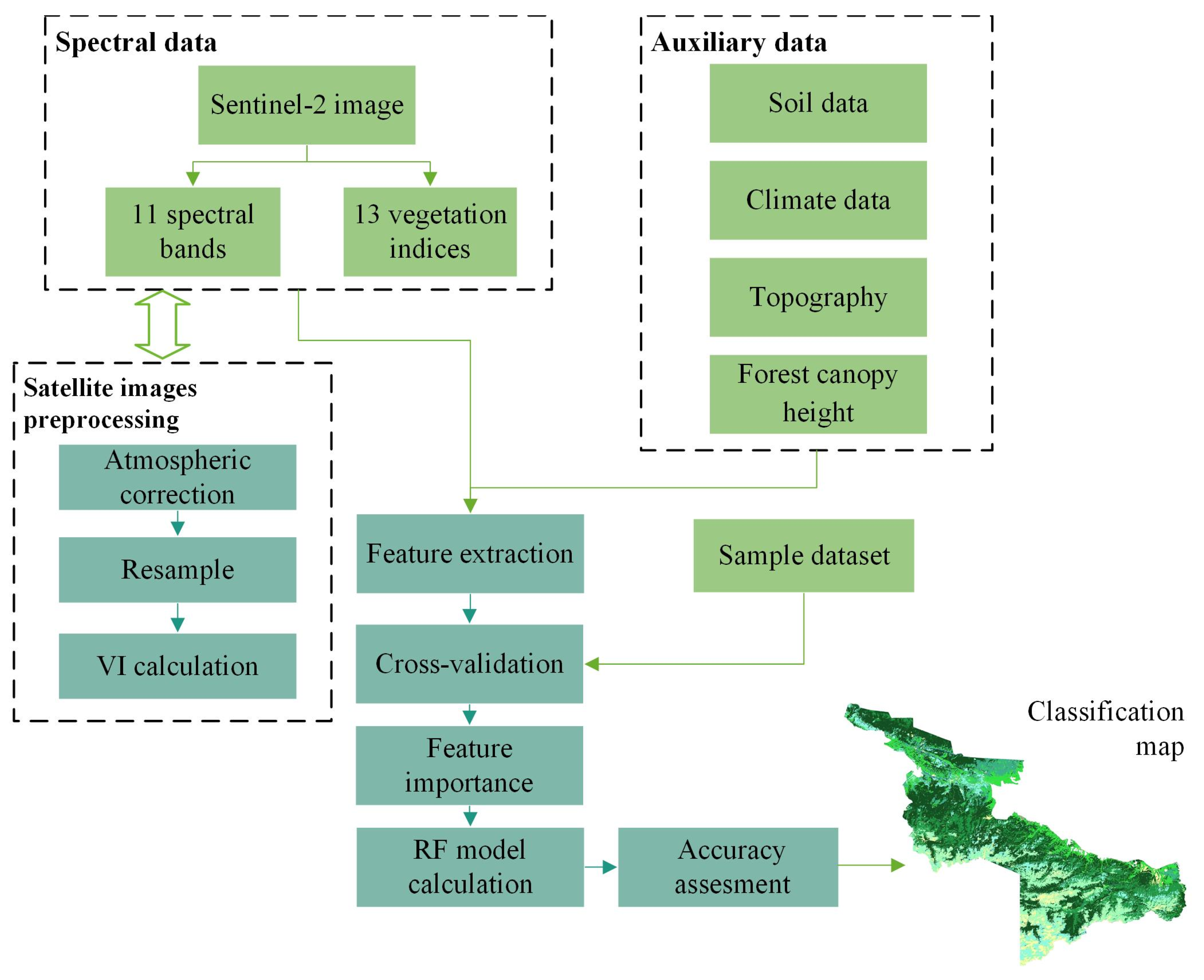
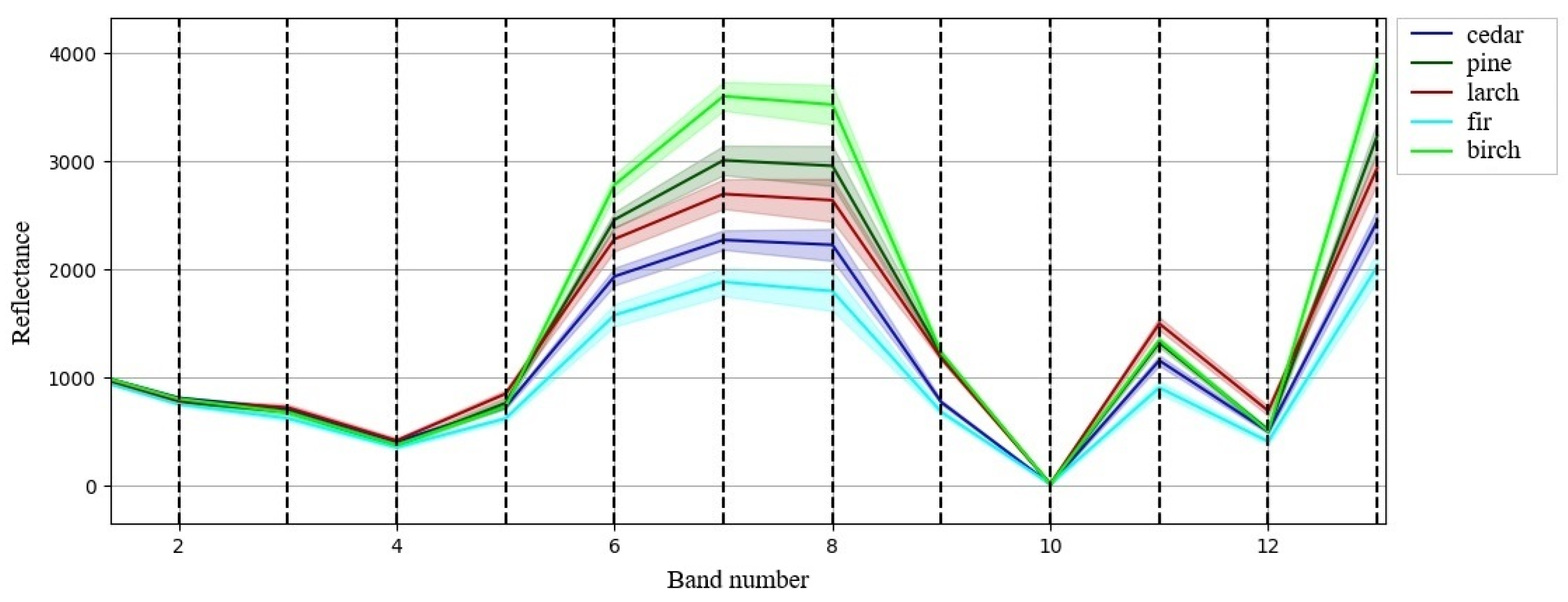

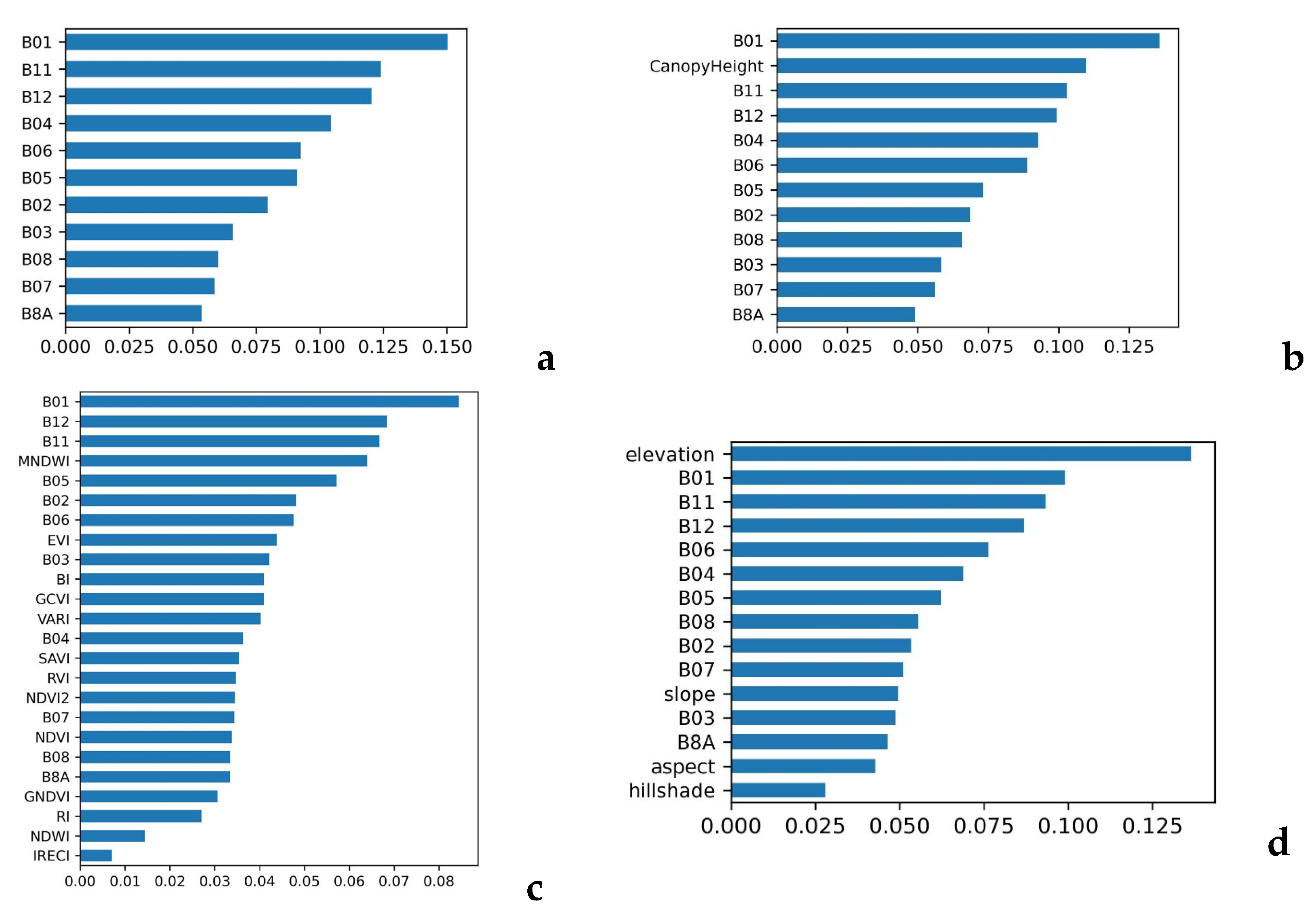
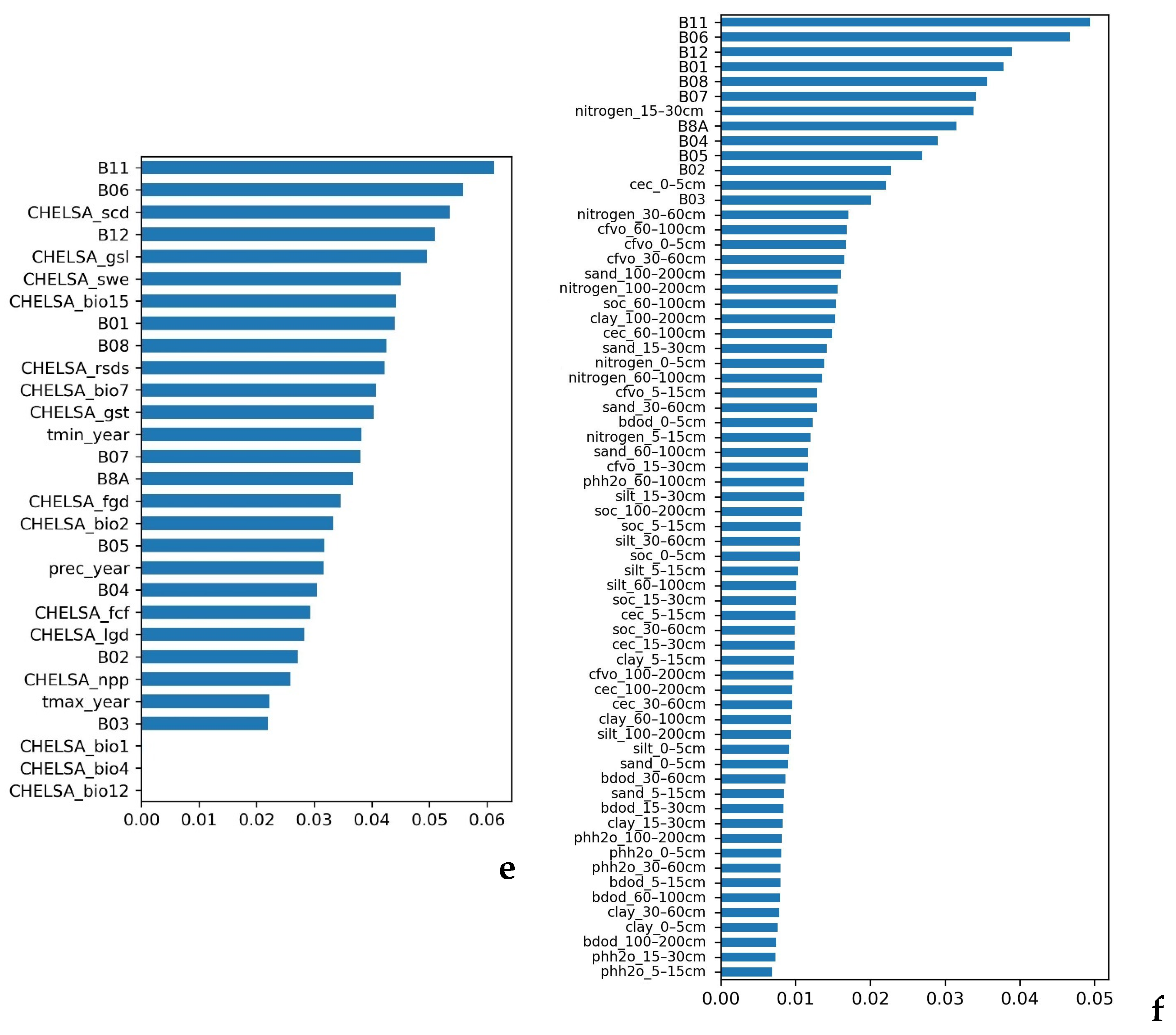
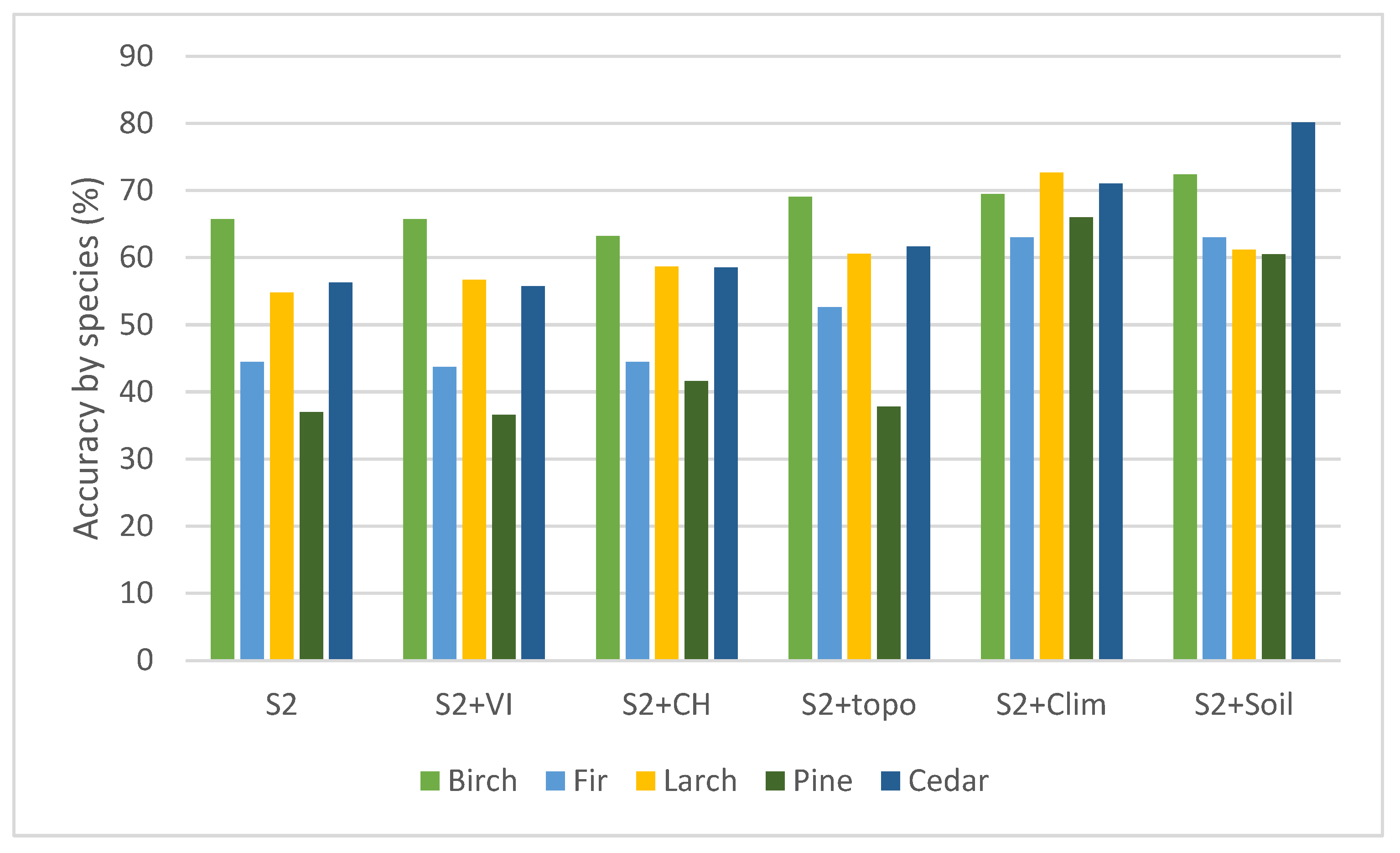

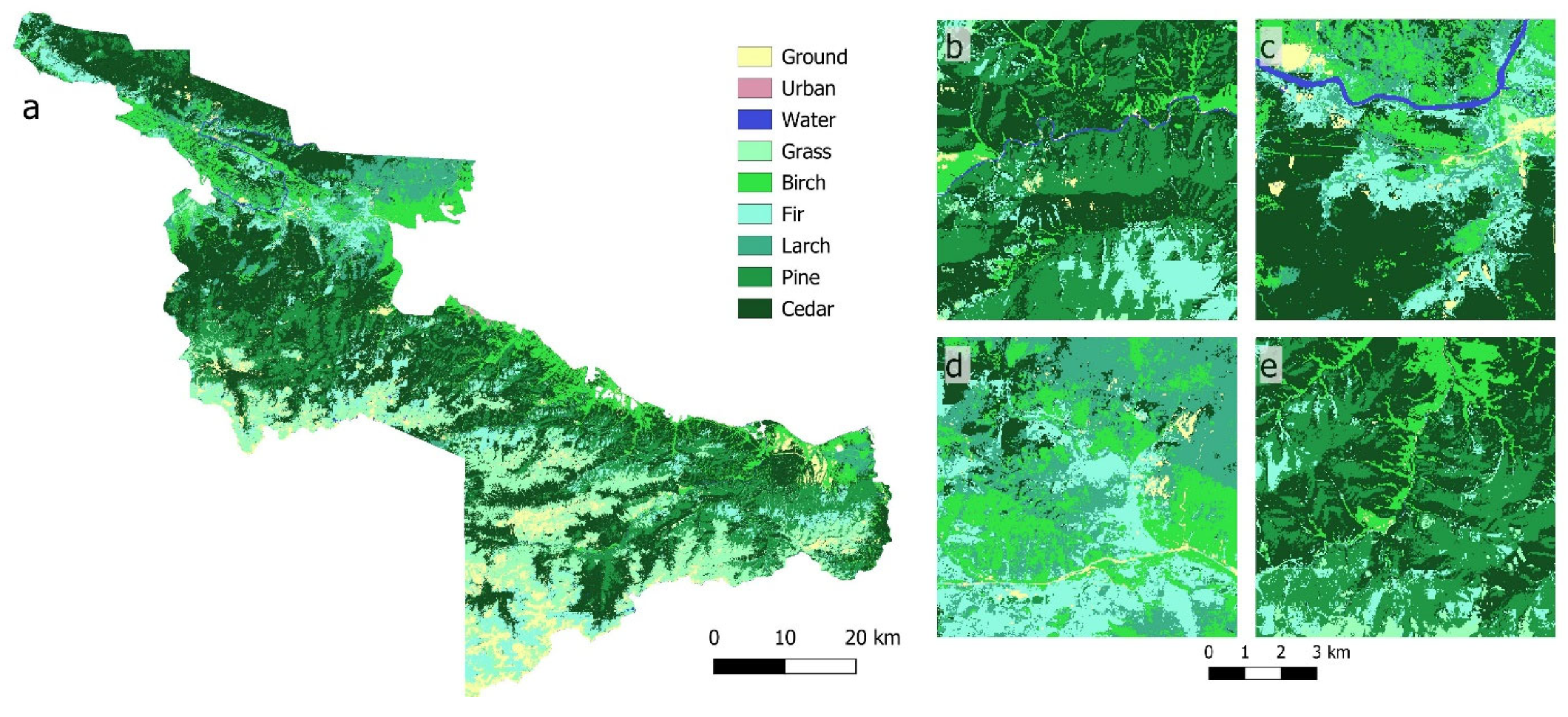
| Data Type | Dataset Features | Features | Description |
|---|---|---|---|
| Vegetation indices | 13 indices | NDVI [32] | |
| RVI [33] | |||
| NDWI [34] | |||
| RI [35] | |||
| EVI [36] | |||
| GNDVI [37] | |||
| IRECI [38] | |||
| BI [39] | |||
| GCVI [40] | |||
| MNDWI [41] | |||
| NDVI2 [32] | |||
| SAVI [42] | |||
| VARI [43] | |||
| Soil | SoilGrids, nine features, for each of the six depth intervals, total 54 features https://www.isric.org/ (accessed on 4 March 2025) | bdod | Bulk density of the fine earth fraction, cg/cm3 |
| cec | Cation Exchange Capacity, mmol(c)/kg | ||
| cfvo | Volumetric fraction of coarse fragments (>2 mm), cm3/dm3 | ||
| clay | Proportion of clay particles (<0.002 mm), g/kg | ||
| nitrogen | Total nitrogen, cg/kg | ||
| phh2o | Soil pH | ||
| sand | Proportion of sand particles (>0.05 mm), g/kg | ||
| silt | Proportion of silt particles (≥0.002 mm and ≤0.05 mm), g/kg | ||
| soc | Soil organic carbon content, dg/kg | ||
| Climate | WorldClim, three features https://worldclim.org/ (accessed on 4 March 2025) | tmax | Average maximum temperature, °C |
| tmin | Average minimum temperature, °C | ||
| precepitation | Precipitation amount, mm | ||
| Chelsa, 15 features https://chelsa-climate.org/ (accessed on 4 March 2025) | bio1 | Mean annual air temperature, °C | |
| bio2 | Mean diurnal air temperature range, °C | ||
| bio4 | Temperature seasonality (standard deviation of the monthly mean temperatures), °C/100 | ||
| bio7 | Annual range of air temperature, °C | ||
| bio12 | Annual precipitation amount, kg/m2 | ||
| bio15 | Precipitation seasonality, kg/m2 | ||
| fcf | Frost change frequency | ||
| fgd | First day of the growing season | ||
| gsl | Growing season length | ||
| gst | Mean temperature of the growing season, °C | ||
| lgd | Last day of the growing season | ||
| npp | Net primary productivity, gC/m2 | ||
| rsds_mean | Mean monthly surface downwelling shortwave flux in air, MJ/m2 | ||
| scd | Snow cover days | ||
| swe | Snow water equivalent, kg/m2 | ||
| Topography | Copernicus Digital Surface Model (DEM), four features https://dataspace.copernicus.eu/ (accessed on 4 March 2025) | aspect | Orientation of the slope in degrees |
| slope | Relief slope angle | ||
| hillshade | Terrain shading | ||
| elevation | Elevation above sea level | ||
| Forest canopy height | ETH Global Sentinel-2 10 m Canopy Height, one feature https://gee-community-catalog.org/projects/canopy/ (accessed on 4 March 2025) | CanopyHeight | Global forest canopy height |
| Total 90 auxiliary features | |||
| Model | Features Combinations | Number of Features |
|---|---|---|
| 1 | Sentinel-2 bands | 11 |
| 2 | Sentinel-2 + vegetation indices (S2 + VI) | 24 |
| 3 | Sentinel-2 + canopy height (S2 + CH) | 12 |
| 4 | Sentinel-2 + topographic features (S2 + topo) | 15 |
| 5 | Sentinel-2 + climate features (S2 + clim) | 29 |
| 6 | Sentinel-2 + soil features (S2 + Soil) | 65 |
| 7 | All collected features | 101 |
| Model | Overall Accuracy % | Precision | Recall | F1 Score |
|---|---|---|---|---|
| S2 | 49.59 | 0.55 | 0.50 | 0.53 |
| S2 + VI | 49.93 | 0.55 | 0.50 | 0.53 |
| S2 + CH | 51.86 | 0.59 | 0.52 | 0.56 |
| S2 + topo | 55.86 | 0.62 | 0.56 | 0.61 |
| S2 + Clim | 67.38 | 0.68 | 0.67 | 0.69 |
| S2 + Soil | 69.86 | 0.70 | 0.70 | 0.70 |
| 101 features | 78.8 | 0.77 | 0.79 | 0.79 |
| Tree Species | S2 | S2 + VI | S2 + CH | S2 + topo | S2 + Clim | S2 + Soil | 101 |
|---|---|---|---|---|---|---|---|
| Birch | 65.69 | 65.69 | 63.18 | 69.04 | 69.46 | 72.38 | 76.57 |
| Fir | 44.44 | 43.7 | 44.44 | 52.59 | 62.96 | 62.96 | 82.22 |
| Larch | 54.78 | 56.69 | 58.6 | 60.51 | 72.61 | 61.15 | 79.62 |
| Pine | 36.97 | 36.55 | 41.6 | 37.82 | 65.97 | 60.50 | 79.83 |
| Cedar | 56.25 | 55.68 | 58.52 | 61.65 | 71.02 | 80.11 | 82.10 |
| Average by species | 51.63 | 51.66 | 53.27 | 56.32 | 68.40 | 67.42 | 80.07 |
Disclaimer/Publisher’s Note: The statements, opinions and data contained in all publications are solely those of the individual author(s) and contributor(s) and not of MDPI and/or the editor(s). MDPI and/or the editor(s) disclaim responsibility for any injury to people or property resulting from any ideas, methods, instructions or products referred to in the content. |
© 2025 by the author. Licensee MDPI, Basel, Switzerland. This article is an open access article distributed under the terms and conditions of the Creative Commons Attribution (CC BY) license (https://creativecommons.org/licenses/by/4.0/).
Share and Cite
Popova, A. Improving the Accuracy of Tree Species Mapping by Sentinel-2 Images Using Auxiliary Data—A Case Study of Slyudyanskoye Forestry Area near Lake Baikal. Forests 2025, 16, 487. https://doi.org/10.3390/f16030487
Popova A. Improving the Accuracy of Tree Species Mapping by Sentinel-2 Images Using Auxiliary Data—A Case Study of Slyudyanskoye Forestry Area near Lake Baikal. Forests. 2025; 16(3):487. https://doi.org/10.3390/f16030487
Chicago/Turabian StylePopova, Anastasia. 2025. "Improving the Accuracy of Tree Species Mapping by Sentinel-2 Images Using Auxiliary Data—A Case Study of Slyudyanskoye Forestry Area near Lake Baikal" Forests 16, no. 3: 487. https://doi.org/10.3390/f16030487
APA StylePopova, A. (2025). Improving the Accuracy of Tree Species Mapping by Sentinel-2 Images Using Auxiliary Data—A Case Study of Slyudyanskoye Forestry Area near Lake Baikal. Forests, 16(3), 487. https://doi.org/10.3390/f16030487






